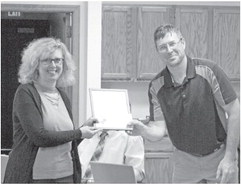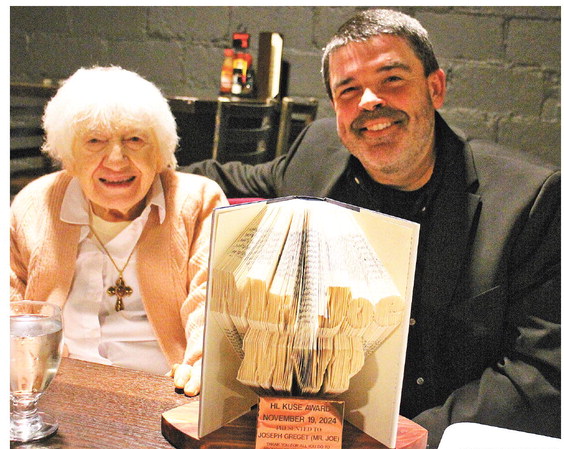Board OKs meals through June, talks building projects


Students in the Medford school district will continue to get home-delivered meals through at least the month of June At Monday’s school board meeting, members approved continuing the popular program that has been in place through the COVID-19 closure of the school buildings. The program is funded at the federal level and this funding would continue through the summer. The cost to the district is about $9,000 for the month, with this being labor to deliver the meals and mileage for the vehicles used. The labor and mileage cost would be billed to the school lunch account which has about $200,000 in its fund balance generated from the sale of meals.
District administrator Pat Sullivan said, the program would involved a full week of meals being delivered to households at one time rather than every day. As a result, the decision was made to not include cartons of milk because of the time involved in delivery and concerns over spoiling. Board member John Zuleger suggested sending along a coupon for the family to purchase a gallon of milk at County Market.
Sullivan said they would look into options since the district would have to purchase the items and be reimbursed through the federal program.
The board discussed the possibility of continuing the program through July and August but held off on committing to delivery with the hope that school buildings could be open in July. A decision will be made at the June 22 board meeting.
The board had a lengthy discussion on the status of a graduation ceremony and summer school. Sullivan noted that the district has been getting approached by people wanting graduation to be held this Friday as originally scheduled or at least for the district to move it earlier than in August.
Sullivan noted that his own son is graduating and he understands the desire for people to have the usual ceremony. However he also had a discussion with the school district’s attorney and the public health department who said that while there would be nothing keeping the district from having a ceremony, if someone got sick following the ceremony then everyone who came in contact with that person would not be allowed to go to work for 14 days. He said that while the attorney said the district “probably wouldn’t lose” a lawsuit, it would cost the district money to defends itself.
“It is a no win,” he said. “ I want to do what we can for all the kids in the senior class.”
Public health director Patty Krug said residents in this area are living in a false sense of security based on there not being any confirmed cases here. She said any event would have to follow social distancing.
Board president Dave Fleegel noted that social distancing was at this point a recommendation. “There is a certain percentage that does not believe the recommendation is necessary,” he said.
Sullivan said he did not see a benefit to changing the date from the announced August 7 date because people have begun making plans for the August date.
“Just keep the date in August,” said board member Oralee Dittrich.
“It seems to loose all it flair by August,” Fleegel said.
“There is a lot of stuff that has lost its flair this year,” Dittrich replied.
High school survey
A recently completed community survey shows broad support for the district to continue to make investments in upgrading the existing high school building. However just what that investment may look like is still a point of discussion.
The district had hired the survey company School Perceptions to run a survey of district residents to gauge public support for a potential renovation, expansion or building project at the high school. The survey was conducted in March to mid-April with 1,596 residents participating. According to School Perceptions, the 25% participation rate was higher than the state average of 18% to 20% participation and the company representative, appearing by conference call described, it as being a very good data set that would yield a survey with results that were within 2.5% margin of error. Demographically, the survey respondents skewed older with the highest group 35-54 years old at 38%, 55-64 years old was 22% and 65 and older was 27%. He noted that 95% of the respondents lived within the district, noting the others were staff members who lived outside the district or parents of students open-enrolled in the district. About 14% of the total pool of respondents were school district employees and about 60% did not have any students in the district.
The survey asked respondents about seven different potential project areas and to rate those on a scale of importance. Potential projects include safety and security upgrades at $2.75 million, major building systems updates at $7.35 million, tech. ed. classrooms at $8 million, adding classrooms at $7.05 million, updating cafeteria/ kitchen at $2.7 million, relocating and expanding the theater and library for $12.5 million and add gym space for $15.3 million.
The cost of all of the projects would have been about $55 million. Based on the survey results, while parents of students (25% of voters) would support spending up to $45 million, the non-parent and non-staff population that makes up about 75% of the voters would likely support a referendum up to $35 million. At the same time, 60% of all respondents supported a plan to continue to make improvements to the existing high school.
One of the questions board members had was how the pandemic will impact the survey result. “I have never been through a pandemic before,” the School Perceptions representative responded, however it was noted that the pandemic was underway during the survey when there was a lot of uncertainty about its severity. He also noted that 95% of the referendums in the state passed on the April election held during the pandemic. “I am surprised, but generally people feel very supportive,” he said.
With the board’s review of the results, the question was raised about what to do next. If the school wanted to proceed with having a referendum on the November general election ballot they would need to decide on the amount and language by the July meeting. However, they could also postpone and bring it to a vote next April.
Sullivan noted he has had a few weeks to review the results and had some ideas. He noted the respondents were pretty clear about the potential to support up to spending $35 million and also had ranked an additional gym and theater at the bottom of the priority list. He noted these are also the highest ticket items with all the other projects totalling $27 million. He said this would still leave the district with about $8 million to fall under the $35 million amount and suggested they could work with Findforff and PRA to go back to the drawing board and see what improvements could be made for that $8 million. “Anything there is an improvement,” he said.
“We are not going to a referendum asking for a $12 million theater and and $15 million gym,” he said.
Hallgren cautioned against getting locked in too tightly, noting that whatever the total amount of the referendum would be it would be the board’s responsibility to spend the money for the best option of the district. “We have to come up with the best plan overall for the dollars,” he said.
Dede Strama said it is important to take the respondents’ priority lists into account and focus on the items at the top of the priority list. Dittrich said she would just as soon not spend the extra $8 million to do smaller upgrades to the gym and theater. “If the end product isn’t what you want why do it,” she said. She expressed concern about the economic conditions as a result of the pandemic. Knight said it is important for the district to have economic facts before deciding whether or not to go to a referendum vote.
Statistically, referendums have a higher rate of passage the higher the voter turnout. This was the idea of behind scheduling it for the presidential election in November. However it was noted that it could just as easily be held in the spring election if the district would be more prepared for it at that time.
Policy
A proposed first reading of a new policy that would establish a “team selection” process that would allow coaches to reduce the number of athletes on squads based on ability and how students did in tryouts, became a broader discussion on the role of the policy committee in relation to the full school board.
The proposed “team selection” policy was brought to the policy committee by a group of coaches. The policy committee then went to work on reviewing it and planned to bring it to the school board for first reading on Monday. All policies must go through two readings and subsequent reviews by the policy committee before they are adopted. However before the “team selection” policy could make it to first reading, Sullivan asked that it be removed because of concerns raised by the administrative team about the policy and the need to address those concerns. This is commonly done in the district with the policy then starting the process over the following month.
Fleegel and Hallgren objected to the idea of the policy in general noting that setting up what was in effect a policy to cut players from teams, was a vast departure from the established goals of the district to encourage participation.
“I read this and I was appalled about the amount of leeway that could happen,” Fleegel said, noting that while coaches have said they would likely not use it, it could change in a heartbeat.
“We have never allowed for a cut policy,” Hallgren said, noting the idea was rejected when it was brought up during his previous time on the board in the 1990s.
“You have to see both sides of the story,” countered Dixon. It was noted that there are tryouts for other things at the school such as choirs or for a part in the high school play.
“The thought process is that we are trying to get kids into things,” Hallgren said.
Board member Cheryl Wibben said it is challenge to find coaches for the additional squads and that many times that coaching is not adequate.
Fleegel and Hallgren also objected that the policy committee took it upon themselves to start the process to make this policy without it first coming to the full board. The idea being that a proposal should first come to the board and then if the board was in favor it, it would go to the committee for a policy to be drafted.
Dixon disagreed and said the process of issues orginating with the policy committee and then coming to the board through the first and second reading process worked fine.
Hallgren disagreed and referenced not only the committee time, but the staff time into policy that would be rejected by the board.
Wibben and Knight objected to the policy committee being dependent on what the board directed them to work on and noted that the finance committee often brings things forward on their own with the full board only finding out about it during the committee report at the school board meeting.
In the end, no action was taken on the team selection policy with it set to go back to the policy committee for a second round of reading at the June policy meeting.
At Monday’s meeting, board president Dave Fleegel (right) presented teacher Lisa Shear with a plaque recognizing her as the Taylor County Educator of the Month.


